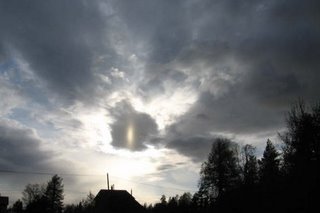Has anyone seen subparhelic circle inside subparhelia? Neither have I. Not before stacking the photos from the latter part of the 12/13 January night. In one of the stacks this missing segment is seen faintly inside subparhelia. The version of the image above, made by Nicolas Lefaudeux, was done with emphasis on getting the segment stand out as clearly as possible.
Below is a more conventional looking version of the image and simulation. The plate oriented crystals in the simulation were fully triangular. Regular hexagons do not make the missing segment, except at very high light source elevations.
What else? The arcs that in Finland these days are called the Schulthess arcs are quite well defined, especially in the last photo set of the night (below). One sees both concave and convex components extending from subparhelia to parhelia, though the latter component seems to have a gap around the horizon, not reproduced by the simulation. I have never seen in sun display photos the concave component between parhelia and horizon. It is always just the convex component that is visible.
Marko Riikonen






